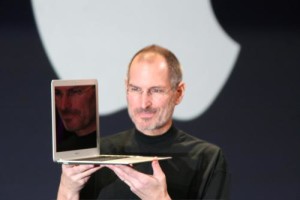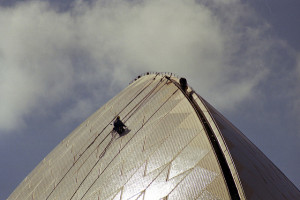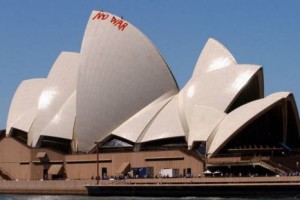Will Saunders and David Burgess were 67 meters up in the sky. Aside from the wind, it was deathly quiet. The roar of the city was miles away.
Balancing precariously on the glazed white granite tiles, they steadied themselves while tightly gripping their buckets of red paint. They couldn’t afford to fall – they had an important statement to make.
Their mission: To vandalise the Sydney Opera House.
Perching on the tallest “sail” of the iconic building, they methodically applied the red paint onto the roof. After applying three coats of paint, they stepped back and admired their handiwork: The words “NO WAR” spelled out in big red letters in stark contrast against the white tiles.
Saunders and Burgess were protesting against the Iraq war and the Australian government’s decision to send troops to support the coalition. In an interview he gave 8 years later, Burgess shared how he “wanted the message to be seen overseas and for people to know that 70 odd percent of Australians were polling against the war in Iraq.”
Malicious act of vandalism? Heroic statement of peace? You can say whatever you like, but make no mistake – it got people’s attention.
Burgess shared:
“A friend of mine who’d been in Iraq at the time, she’d been in a cafe and the television came on with the image on it and she said the whole place cheered. And that is essentially what I wanted to achieve out of defacing an Australian icon.”
“I think if we’d had the idea and then not gone through with it we would have wondered or thought we should have done that.”
I heard this story while I was on a walking tour in Sydney last weekend. Sydney has some incredible stories, but this was by far my favourite. And it got me thinking about how I can improve my own messages to make them more compelling, memorable, and sticky.
Average Messages Get Average Results
 We live in a world of boring, mediocre messages: The same PowerPoint decks, the same superficial conversations, the same job applications.
We live in a world of boring, mediocre messages: The same PowerPoint decks, the same superficial conversations, the same job applications.
Normalcy is comforting. It’s reassuring: if everyone is doing the same thing, it’s probably okay.
Think about how the average cover letter sounds:
“To Whomever It May Concern, it is my esteemed honour to apply for your role of Customer Services Associate. With my four years of experience at ABC company, I have had many years of exposure dealing with many types of customers. I am willing to work hard…. yadda yadda yadda”
YAWN. The average recruiter reads 50-60 of these a day, and the majority of them end up in the trash. Is it any wonder that candidates find themselves applying to 100 jobs but don’t hear back from a single one?
Or let’s take how most companies approach marketing:
- They form a committee
- They have meetings and meetings talking about how to “make this go viral”
- They hold a brainstorming workshop
- They spend hundreds of thousands of dollars on advertising
- Their ads look exactly like every other ad
A Simple Model For Getting People’s Attention
If you’re thinking about landing your dream job, launching your own business, or getting people’s attention in any sort of way, it’s important to figure out how to make your message sticky.
Luckily, it doesn’t (necessarily) have to involve doing anything illegal.
In the book “Made To Stick”, the Heath Brothers lay out a model for creating “sticky” messages, using the acronym SUCCESs:
- Simple
- Unexpected
- Concrete
- Credible
- Emotional
- Stories
I read this book a couple of years ago and I still find myself referring to it every now and then. I won’t spoil the book for you, but let’s think about how you could turn a seemingly boring message into something that sticks:
If you wanted to make an anti-war statement, you could get a petition signed and gather some protestors. Or you could paint NO WAR on the Sydney Opera House (Simple, Unexpected, Emotional).
 If you were giving a presentation about your company’s newest slim laptop, you could cobble together some PowerPoint slides with technical specifications. Or you could do what Steve Jobs did when he unveiled the MacBook Air: Slide it out of an envelope. That one gesture alone said more than 20 PowerPoint slides. (Simple, Concrete, Credible)
If you were giving a presentation about your company’s newest slim laptop, you could cobble together some PowerPoint slides with technical specifications. Or you could do what Steve Jobs did when he unveiled the MacBook Air: Slide it out of an envelope. That one gesture alone said more than 20 PowerPoint slides. (Simple, Concrete, Credible)
If you were applying for a job, you could submit your resume through the company’s job portal. Or you could do what Nina Mufleh in her Airbnb job application. She created a stunning website that mirrors the Airbnb site, including a thorough analysis of the untapped Middle Eastern market, backed up with data. (Unexpected, Concrete, Credible)
If your company tasked you to hire an intern, you could simply post a job description on LinkedIn. Or you could do what Standard Chartered did and launch a “World’s Coolest Intern” campaign. It was so masterfully executed that it still has social media blogs raving about it 6 years later. (Simple, Concrete, Stories)
Average messages get average results. If you really want to be heard and – more importantly – remembered, you have to send a message that’s sticky.
So today, let me challenge you to think about how you can make your own messages stickier: In emails, presentations, projects, and even your out-of-office message.
(I once had a colleague who included a hilarious word search puzzle in his out-of-office autoresponder – which I totally spent 20 minutes trying to solve)
Epilogue
Burgess and Saunders were eventually sentenced to jail for nine months’ weekend detention for malicious damage. They were also ordered to pay a fine of $151,000, equivalent to the costs of cleaning up the red paint.
But in a deliciously cheeky act of defiance, they bought as many of those awfully tacky Opera House souvenirs as they could, wrote “NO WAR” on them, and then sold them to tourists outside the Opera House.
It took them 18 months, but they paid it back in full.
Sources: The Australian, ABC Sydney, The Sydney Morning Herald, BBC, The Financial Brand, stories from my tour guide (I’m Free Tours)
Image credits: Anthony J Shepherd, Wolves68450, Detroity2k

